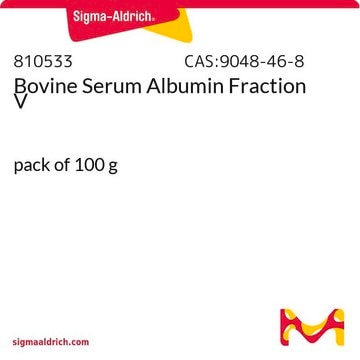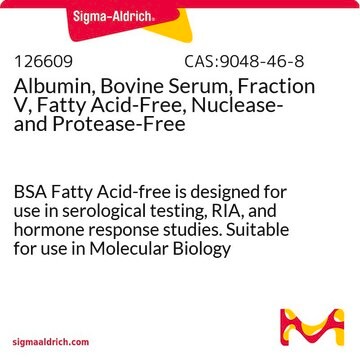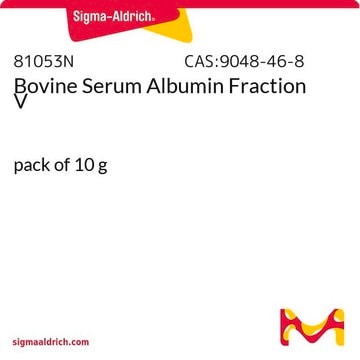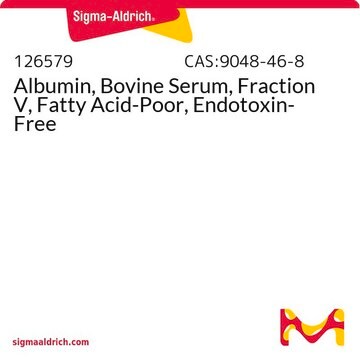03117332001
Roche
Bovine Serum Albumin Fraction V, protease-free
from bovine serum
Sign Into View Organizational & Contract Pricing
All Photos(1)
About This Item
UNSPSC Code:
12352202
NACRES:
NA.21
Recommended Products
biological source
bovine
Quality Level
Assay
≥98.5% albumin basis (electrophoresis)
form
lyophilized
packaging
pkg of 50 g
manufacturer/tradename
Roche
technique(s)
ELISA: suitable
shipped in
wet ice
storage temp.
2-8°C
General description
Bovine serum albumin (BSA) is a globular, α-helical, non-glycosylated protein is produced in the liver. It consists of three homologous, structurally different domains and two sub-domains each. BSA has 17 cysteine residues cross-linked and bound into a single chain.
Application
Bovine Serum Albumin Fraction V, protease-free is used:
- for stabilization of purified enzymes
- for site-blocking reagent in ELISA techniques
- as a protein standard for determination of protein concentration
Biochem/physiol Actions
Bovine Serum Albumin (BSA) facilitates the transmission of drugs, hormones, and fatty acids. It is the most commonly used blocking agent in enzyme-linked immunosorbent assay (ELISA). BSA enhances the differentiation of human embryonic stem cells (hESC) and is also a chief component of cell culture media.
Quality
Contaminants: ≤0.001% heavy metals; proteases not detectable (casein digest)
Other Notes
For life science research only. Not for use in diagnostic procedures.
Storage Class Code
11 - Combustible Solids
WGK
WGK 1
Flash Point(F)
Not applicable
Flash Point(C)
Not applicable
Certificates of Analysis (COA)
Search for Certificates of Analysis (COA) by entering the products Lot/Batch Number. Lot and Batch Numbers can be found on a product’s label following the words ‘Lot’ or ‘Batch’.
Already Own This Product?
Find documentation for the products that you have recently purchased in the Document Library.
Customers Also Viewed
Glennys V Reynoso et al.
Methods in molecular biology (Clifton, N.J.), 2023, 287-299 (2019-06-27)
This chapter provides methods for the propagation, purification, and titration of vaccinia virus (VACV) and the highly attenuated strain-modified vaccinia Ankara (MVA). Additionally, we provide information on VACV recombinants we have used for intravital imaging with multiphoton excitation.
Drew C Tilley et al.
The Journal of general physiology, 151(3), 292-315 (2018-11-07)
Allosteric ligands modulate protein activity by altering the energy landscape of conformational space in ligand-protein complexes. Here we investigate how ligand binding to a K+ channel's voltage sensor allosterically modulates opening of its K+-conductive pore. The tarantula venom peptide guangxitoxin-1E
Amanda B Hummon et al.
BioTechniques, 42(4), 467-470 (2007-05-11)
A systems approach is being applied in many areas of the biological sciences, particularly in cancer research. The coordinated, simultaneous extraction of DNA, RNA, and proteins from a single sample is crucial for accurate correlations between genomic aberrations and their
Yuhong Xiao et al.
Journal of immunological methods, 384(1-2), 148-151 (2012-06-27)
The enzyme-linked immunosorbent assay (ELISA) is an extremely common and powerful laboratory technique for detecting proteins by antibodies. Researchers frequently use bovine serum albumin (BSA) as a blocking agent to prevent non-specific binding of antigens and antibodies to the microtiter
D J Speca et al.
Genes, brain, and behavior, 13(4), 394-408 (2014-02-06)
The Kv2.1 delayed rectifier potassium channel exhibits high-level expression in both principal and inhibitory neurons throughout the central nervous system, including prominent expression in hippocampal neurons. Studies of in vitro preparations suggest that Kv2.1 is a key yet conditional regulator
Our team of scientists has experience in all areas of research including Life Science, Material Science, Chemical Synthesis, Chromatography, Analytical and many others.
Contact Technical Service









